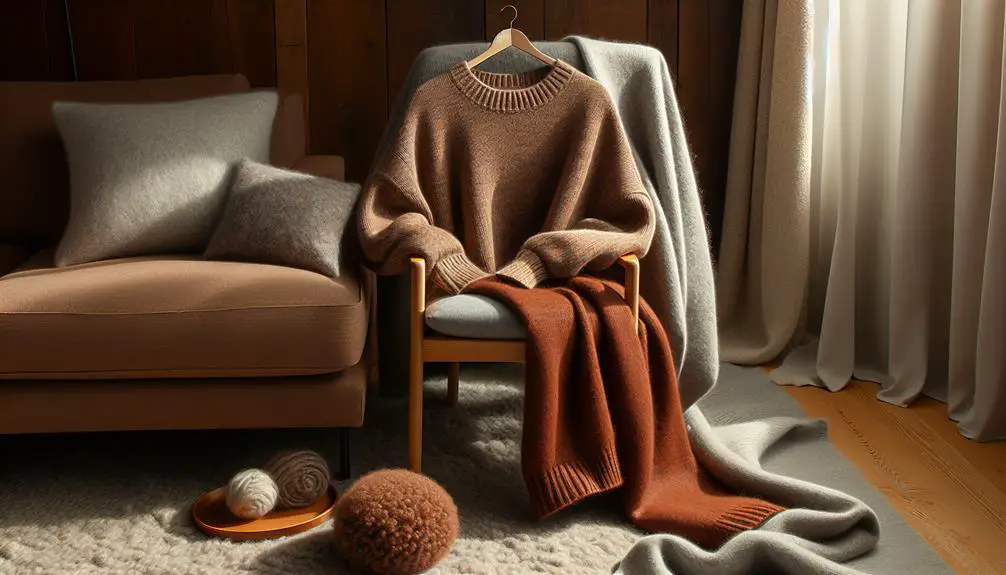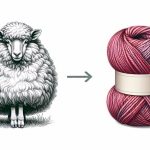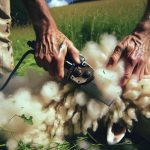I believe wool is the best material because it offers natural comfort and sustainability that suits various needs. It comes from sheep, making it renewable and eco-friendly. Wool keeps me dry and cozy by absorbing moisture and regulating temperature. Its breathability prevents odors and insulates well. Plus, wool is durable, stretchy, and resists wrinkles. Even when wet, wool retains warmth better than other materials. Its low environmental impact and support for local communities make it a versatile and sustainable choice. Try wool for a comfy, eco-friendly lifestyle that suits all seasons.
Table of Contents
Key Takeaways
- Natural and renewable fiber source from sheep
- Exceptional breathability and moisture-wicking
- Odor resistance and insulation qualities
- Durability, elasticity, and wrinkle resistance
- Warmth retention even when wet
Natural and Renewable Fiber Source
Wool stands out as the best material due to its natural and renewable fiber source, sourced from sheep and known for its sustainability. The wool fiber is unique in its ability to absorb moisture while still regulating temperature effectively. This feature makes it ideal for various weather conditions, keeping you comfortable whether it's hot or cold outside.
I've always admired how wool can keep me warm in the winter without overheating and yet remain cool in the summer. The wool fiber's structure allows it to trap air, providing insulation, while also wicking away moisture to keep you dry. This natural moisture-wicking property is unmatched by synthetic fibers, making wool a top choice for activewear and outdoor gear.
Moreover, the temperature regulation of wool is exceptional. It can help your body maintain a stable temperature by releasing heat when it's hot and retaining it when it's cold. This adaptability makes wool a versatile and reliable material for a wide range of clothing and products.
Exceptional Breathability and Moisture-Wicking
With its ability to create natural air pockets, wool offers exceptional breathability and moisture-wicking properties that set it apart from other materials. Wool fibers are like little champions at keeping you cool and dry. Let's break it down:
| Benefits of Wool | How it Helps |
|---|---|
| Breathability | Wool fibers naturally create air pockets, allowing your skin to breathe easily. This keeps you cool during workouts or warm days. |
| Moisture-Wicking | Wool is a moisture-wicking superstar! It absorbs sweat without feeling damp, leaving you feeling fresh and dry. Perfect for intense activities. |
| Regulates Body Temperature | Wool's magical ability to wick away moisture helps regulate your body temperature. It keeps you cozy in the winter and cool in the summer. |
| Ideal for Activewear | Thanks to its breathability and moisture-wicking prowess, wool is a top choice for activewear. It keeps you comfortable during all your fitness adventures. |
| Great for Outdoor Clothing | When you're out exploring, wool's breathability and moisture-wicking properties make it a fantastic choice for outdoor clothing. Stay dry and comfortable on every adventure. |
Odor Resistance and Insulation Qualities
Thanks to its natural properties, wool keeps you feeling fresh and odor-free even after multiple wears. Unlike synthetic fabrics that tend to retain odors, wool's moisture-wicking properties help prevent the buildup of smells, making it an excellent choice for activewear and outdoor clothing.
This odor resistance is a game-changer, allowing you to wear wool garments multiple times without the worry of unpleasant smells lingering on the fabric. Not only does wool excel in keeping odors at bay, but it also boasts exceptional insulation properties. Wool fibers trap air, creating a natural barrier against the cold, keeping you warm and cozy in various weather conditions.
This makes wool a versatile material that can be worn comfortably throughout different seasons. Whether you're out for a hike, hitting the gym, or simply running errands, wool's odor resistance and insulation qualities make it a top pick for those seeking both performance and comfort in their clothing choices.
Durability, Elasticity, and Wrinkle Resistance
I adore how wool's natural elasticity and wrinkle resistance make it a hassle-free and long-lasting choice for clothing. Wool fibers have a unique ability to stretch and bounce back to their original shape, making them incredibly durable. This elasticity not only guarantees that wool garments retain their form after wear but also makes them resistant to tearing and abrasion, standing up well to everyday use. Additionally, wool's wrinkle resistance means that clothes made from this material maintain a neat and smooth appearance without the need for constant ironing or pressing.
Furthermore, the resilience of wool is remarkable. Even when stretched, folded, or subjected to various movements, wool retains its shape and structure. This quality contributes to the longevity of wool products, as they can withstand the test of time and maintain their integrity. So, if you're looking for clothing that combines durability, elasticity, wrinkle resistance, and resilience, wool is unquestionably the top choice.
Warmth Retention Even When Wet
I love how wool keeps me warm even when it's wet.
It's amazing that wool can absorb moisture and still feel dry, maintaining its insulating properties.
Wool truly is a game-changer for staying cozy in any weather conditions.
Wet Warmth Retention
In wet conditions, wool not only retains warmth but also surpasses its dry insulation capabilities, making it a standout choice for staying cozy even when damp. Wool's ability to absorb moisture from your skin without feeling wet allows it to maintain its insulating properties even when soaked. This unique feature sets wool apart from many other fabrics, as wet wool actually provides better warmth retention than when it's dry.
For instance, Norwegian fishermen used wet wool mittens for added warmth while working in cold, damp environments. The myth that wet wool is uncomfortable is debunked by the fact that it can keep you warm even in wet conditions. So, when it comes to wet warmth retention, wool fabric truly shines.
Wools Water Resistance
Wool's remarkable water resistance not only repels liquid water on its outer surface but also aids in quick drying and maintaining warmth even when wet. As a moisture-wicking material, wool can absorb up to 30% of its weight in water without feeling wet, making it perfect for wet conditions. Its insulating properties remain intact due to its hygroscopic nature, allowing it to absorb water vapor from the air and still keep you warm. The ability of wool to release heat when water vapor condenses provides additional warmth even in damp environments. Below is a table highlighting the key points of wool's water resistance:
| Key Points | Description |
|---|---|
| Water Repellent | Wool fibers repel liquid water, aiding in quick drying and warmth retention. |
| Moisture Absorption | Can absorb up to 30% of its weight in water without feeling wet. |
| Insulating Properties | Maintains warmth even when wet, thanks to its hygroscopic nature. |
| Heat Release Capability | Releases heat when water vapor condenses, providing extra warmth. |
Moisture Management Benefits
With its exceptional ability to absorb moisture without feeling wet, wool guarantees warmth retention even in damp conditions. Wool fibers can absorb up to 30% of their weight in moisture, making them ideal for moisture management.
Even when wet, wool retains warmth, providing insulation and comfort. The structure of wool fibers allows for a slow release of heat from perspiration vapor, maintaining warmth around the body.
Additionally, wool's hygroscopic nature enables it to adsorb water from the air, contributing to its moisture management benefits. This unique feature of wool not only keeps you dry but also assures that you stay warm and cozy, making it a top choice for various outdoor activities and everyday wear.
Low Environmental Impact and Biodegradability
Embracing wool for its low environmental impact and biodegradability is a smart choice for those looking to reduce their ecological footprint. Wool stands out as a sustainable material that benefits both our planet and our wardrobe.
Here are three reasons why wool is an environmentally friendly option for clothing:
- Renewable Resource: Wool comes from sheep, a natural and renewable source. This means that the production of wool has less impact on the environment compared to materials that require extensive industrial processes.
- Biodegradability: When disposed of, wool garments naturally decompose without releasing harmful substances into the environment. This ability to break down organically contributes to a cleaner planet and lessens the burden on landfills.
- Low Carbon Footprint: Wool production generates fewer greenhouse gases compared to the production of synthetic materials. By choosing wool over other fabrics, you're making a conscious decision to reduce your carbon footprint and support sustainable practices.
Versatile and Sustainable Clothing Choice
Considering its adaptability and positive impacts, wool emerges as a top choice for sustainable and versatile clothing options. Wool is a versatile material that excels in various climates due to its natural temperature regulation properties. It keeps you warm in the cold and cool in the heat, making it suitable for all seasons. Additionally, wool is excellent at moisture-wicking, keeping you dry and comfortable throughout the day. This makes it a fantastic choice for active individuals or those living in areas with unpredictable weather.
Moreover, wool's versatility extends beyond its functional benefits. It's a sustainable choice as it can be recycled and reused easily, reducing waste and promoting a circular economy. By choosing wool clothing, you not only invest in quality pieces that can last a long time but also support sustainable practices in the fashion industry. Embracing wool as a go-to fabric for your wardrobe is a step towards a more environmentally friendly and stylish lifestyle.
Support for Local Communities and Artisans
Supporting local wool industries is essential for empowering communities, providing sustainable livelihoods, and preserving cultural heritage.
By choosing wool products, we directly contribute to the well-being of artisans who rely on traditional techniques passed down through generations.
Let's explore how our support can make a significant impact on local weavers and the preservation of their invaluable craftsmanship.
Empowering Local Weavers
By empowering local weavers, we embrace traditional craftsmanship and support vibrant communities. Local weavers play an essential role in preserving our cultural heritage and passing down valuable skills through generations. Here are three reasons why empowering them is vital:
- Preservation of Traditional Craftsmanship: Local weavers uphold age-old techniques and designs that are fundamental to our cultural identity.
- Community Sustainability: Supporting local weavers bolsters the local economy, ensuring that artisans can continue their craft and provide for their families.
- Promotion of Sustainable Practices: Empowering local weavers often leads to the adoption of eco-friendly and sustainable production methods, benefiting both the environment and the community at large.
Sustainable Livelihoods Supported
Let's explore how sustainable livelihoods are supported through the backing of local communities and artisans in the domain of wool production.
The wool industry plays a vital role in bolstering local communities and economies, offering livelihoods to shepherds, farmers, and artisans. By creating jobs in rural areas, it contributes to sustainable livelihoods for many families, while also preserving traditional skills and craftsmanship within communities through local wool processing and manufacturing.
Opting for wool products allows consumers to directly support small-scale farmers and artisans, fostering ethical treatment of animals and environmental conservation. This ethical approach benefits not only the environment but also the well-being of those involved in the production process, making the wool industry a key player in supporting sustainable livelihoods within local communities.
Cultural Heritage Preservation
Preserving cultural heritage and traditional craftsmanship, wool production stands as a cornerstone in supporting local communities and artisans.
3 Ways Wool Upholds Cultural Heritage:
- Empowering Local Communities: Indigenous groups rely on wool production for their livelihood and cultural identity, fostering a sense of community pride and tradition.
- Preserving Traditional Craftsmanship: Artisans skillfully weave wool fibers using age-old techniques, creating high-quality products that showcase generations of expertise.
- Sustaining Authenticity: By buying wool products, you directly support local economies and help sustain traditional crafting practices, ensuring each item carries a unique touch and historical significance.
Wool's ability to trap body heat in its air pockets, combined with the artistry of traditional craftsmanship, results in products that not only keep you warm but also tell a story of heritage and skill.
Frequently Asked Questions
Why Wool Is the Best Fabric?
Wool is the best fabric because of its incredible properties – all-weather protection, breathability, and comfort. No man-made fiber matches its benefits. Plus, it's eco-friendly and renewable. That's why I choose wool over any other material.
What Is so Special About Wool?
Wool is exceptional for its warmth, breathability, moisture-wicking, durability, and UV protection. It's my go-to for all seasons due to its versatility. I love how it keeps me cozy in winter and cool in summer.
Why Do People Love Wool?
People love wool because of its versatility, comfort, and sustainability. It keeps me warm in winter, wicks away moisture, and stays fresh. Wool's natural properties, like UV protection and durability, make it a top choice for many.
What Are the Best Qualities of Wool?
Wool's best qualities include trapping heat, being breathable, moisture-wicking, odor-resistant, soft, durable, and offering UV protection. It's my go-to for warmth, comfort, and sustainability. I love how wool keeps me cozy year-round.
- How Does Ring Spun Cotton Affect Garment Fit and Shape Retention? - August 13, 2024
- What Are the Challenges in Producing Ring Spun Cotton? - August 13, 2024
- Is Ring Spun Cotton Suitable for Plus-Size Clothing? - August 13, 2024





